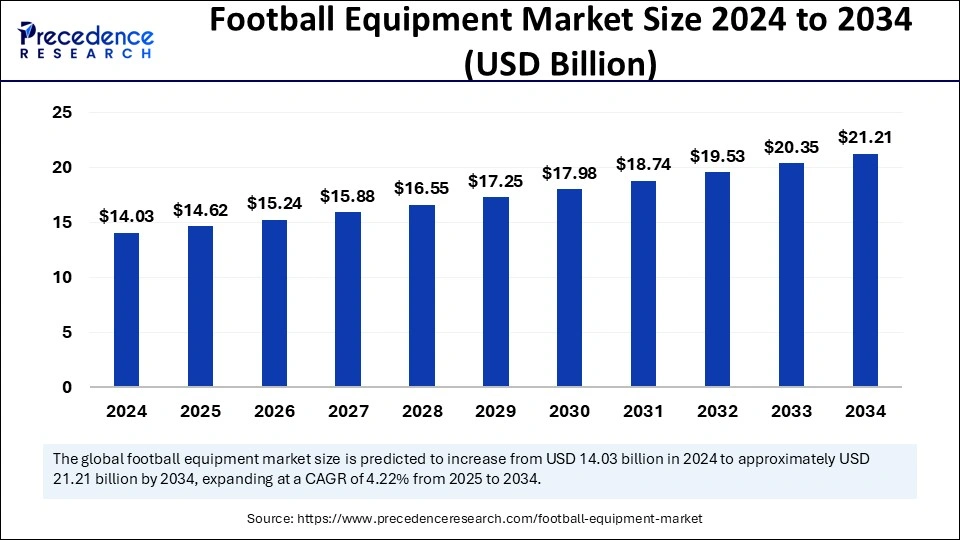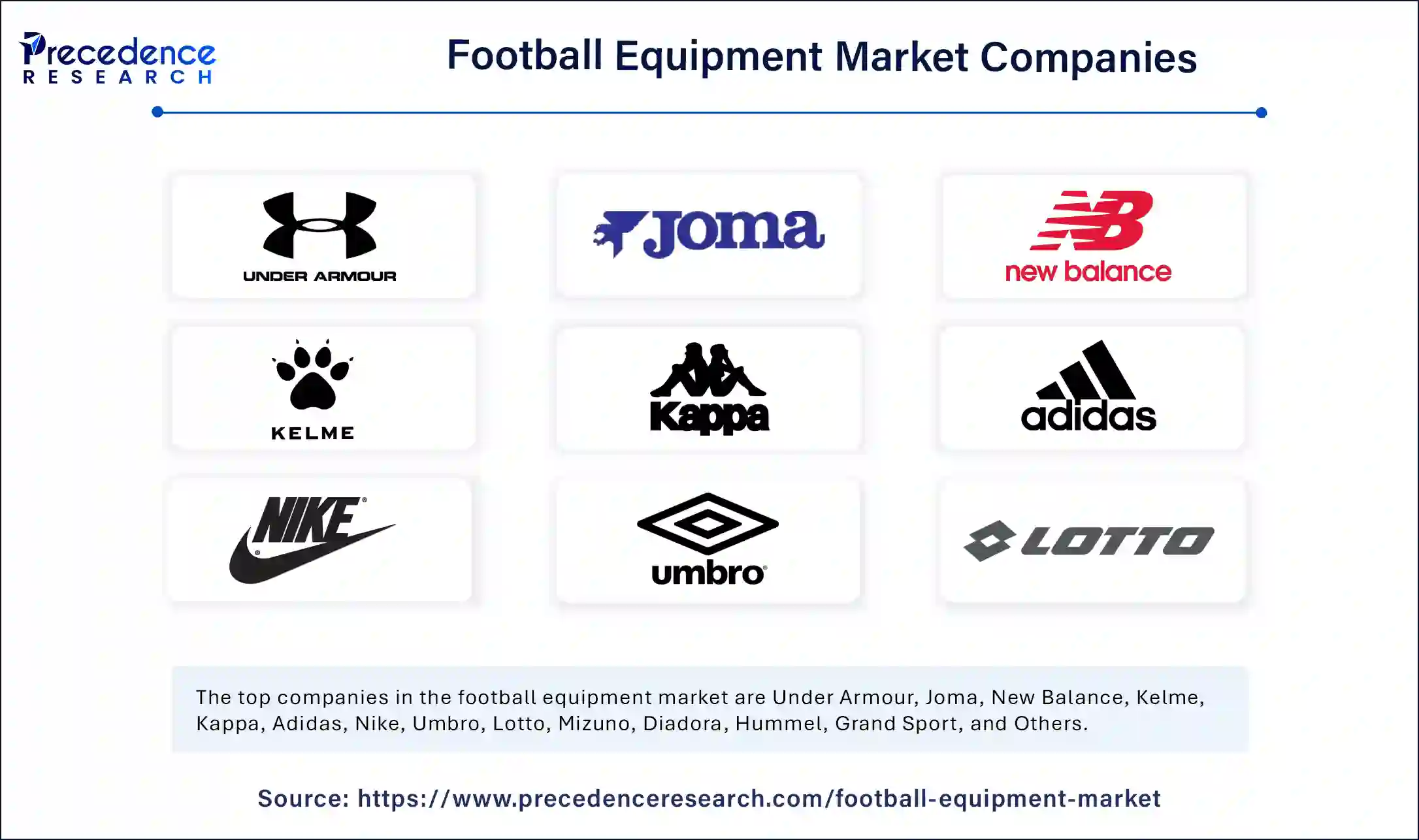The global football equipment Market is forecasted to increase from USD 14.03 billion in 2024 to USD 21.21 billion by 2034, growing at a CAGR of 4.22%.

Football Equipment Market Key Takeaways
-
North America dominated the global market with 36% of the share in 2024.
-
Europe is forecasted to grow at the highest rate in the coming years.
-
The football product segment captured the largest market share in 2024.
-
The footwear segment is predicted to grow at the fastest CAGR between 2025 and 2034.
-
Leather materials held the largest share in 2024.
-
Synthetic materials are expected to witness remarkable growth during the forecast period.
-
The offline distribution channel was the largest in 2024.
-
The online segment is expected to show the fastest CAGR during the period from 2025 to 2034.
-
Professional players held the highest market share by end-user in 2024.
-
The youth player segment is projected to experience considerable growth during the forecast period.
Impact of AI on the Football Equipment Market: Enhancing Performance and Innovation
AI is transforming the football equipment market by improving both player performance and product design. AI-driven wearables and sensors help track real-time data on players’ movements, speed, and fatigue, allowing for data-driven decisions to optimize training and prevent injuries. Additionally, AI is enabling the development of personalized football gear, such as customized footwear and protective equipment, based on player preferences and biomechanics, ensuring better comfort and performance.
Moreover, AI is enhancing the training process with smart footballs and virtual coaching assistants that provide real-time feedback to improve skills. In terms of logistics, AI is optimizing inventory management and supply chains, forecasting demand, and ensuring timely availability of products. AI also enhances the consumer experience through personalized recommendations and virtual try-ons, making it easier for players to select the right equipment.
Football Equipment Market Growth Factors
-
Increasing Participation in Football: With football gaining popularity globally, there has been a steady rise in participation, both at the professional and amateur levels. As the number of players increases, the demand for high-quality football equipment such as balls, footwear, protective gear, and training tools has surged.
-
Rising Sports Awareness and Popularity: The global popularity of football, especially with major tournaments like the FIFA World Cup and regional leagues, has increased awareness about the importance of professional-grade equipment. This has driven the demand for top-tier football gear across various age groups and skill levels.
-
Technological Advancements in Equipment Design: The incorporation of technology in football equipment, such as advanced materials for footwear, enhanced performance tracking tools, and protective gear, has contributed to market growth. The desire for lightweight, durable, and performance-enhancing products has pushed manufacturers to innovate and cater to the evolving needs of players.
-
Increasing Sponsorships and Brand Collaborations: Partnerships between football teams, athletes, and global brands have promoted the growth of football equipment sales. Sponsorships and endorsements have led to greater exposure of equipment brands, encouraging the adoption of new products in both the professional and amateur sectors.
-
Rise in Football-related Events and Competitions: The increase in global football tournaments, leagues, and grassroots competitions has boosted demand for football equipment. The need for specialized gear for different age groups, teams, and playing conditions has fueled the expansion of the market.
-
Focus on Youth Sports Development: Many countries are investing heavily in youth sports development programs, which has spurred demand for football equipment for children and young athletes. With more young players involved in organized football, there is a steady market for equipment that is specifically designed for them.
-
Growing E-commerce Channels: The shift to online shopping has allowed football equipment companies to reach a broader audience. Consumers can now easily access a variety of football gear through e-commerce platforms, fueling market growth as online retail continues to rise in popularity.
Football Equipment Market Overview
The football equipment market is a vital segment within the global sports equipment industry. It includes a wide range of products designed for the sport, such as footballs, footwear, protective gear (shin guards, goalkeeper gloves, etc.), and accessories. With football being one of the most popular and widely played sports globally, the demand for football equipment continues to rise across all levels—from professional athletes to amateur players.
The market is driven by the increasing popularity of football and advancements in product design and materials, providing better comfort, performance, and safety for players. Additionally, the market is seeing significant growth as e-commerce platforms offer convenient access to a wide range of products.
Football Equipment Market Scope
| Report Coverage | Details |
| Market Size by 2034 | USD 21.21 Billion |
| Market Size in 2025 | USD 14.62 Billion |
| Market Size in 2024 | USD 14.03 Billion |
| Market Growth Rate from 2025 to 2034 | CAGR of 4.22% |
| Dominating Region | North America |
| Fastest Growing Region | Asia Pacific |
| Base Year | 2024 |
| Forecast Period | 2025 to 2034 |
| Segments Covered | Product Type, Material, Distribution Channel, End-User, and Regions |
| Regions Covered | North America, Europe, Asia-Pacific, Latin America, and Middle East & Africa |
Football Equipment Market Dynamics
Drivers
The major drivers of the football equipment market include the growing global popularity of football, especially with events like the FIFA World Cup, regional leagues, and increasing participation in youth football programs. Technological advancements in football gear, such as lightweight, durable materials, and the integration of smart technologies like sensors in balls and footwear, are further boosting the market.
Additionally, the increasing focus on sports safety, performance improvement, and the rising number of professional and amateur players are driving demand for high-quality football equipment. The growing trend of online retail and e-commerce is also expanding market reach and access to products.
Opportunities
The football equipment market offers numerous opportunities, particularly in emerging economies where football’s popularity is increasing rapidly. The growth of grassroots and youth football programs presents an opportunity for brands to tap into new consumer segments. Furthermore, the demand for eco-friendly, sustainable products is creating opportunities for brands to innovate in terms of materials and manufacturing processes.
The ongoing technological advancements in product design, such as customizable football footwear and smart footballs, present new avenues for market growth. Additionally, expanding sponsorships and collaborations between top football brands and athletes are enhancing brand visibility and consumer engagement.
Challenges
Despite the market’s growth, several challenges exist. One of the main challenges is the high cost of premium football equipment, which can be a barrier to entry for amateur players, especially in developing regions. Counterfeit products and low-quality alternatives flooding the market also pose a significant challenge, as they can undermine the reputation of established brands.
Additionally, the fluctuation in raw material costs and production issues related to global supply chains can impact market dynamics. Another challenge is the limited awareness in certain regions about the benefits of high-quality football equipment, which can hinder market penetration in those areas.
Regional Insights
Regionally, North America holds a significant share of the football equipment market, with major consumer markets in the U.S. and Canada. The region’s demand is driven by the popularity of both professional and amateur football leagues, as well as increasing participation in youth football programs. Europe is another key market, with countries like the U.K., Germany, and Spain leading in both the football culture and the demand for high-performance football equipment.
Asia-Pacific is expected to witness the fastest growth in the coming years, driven by the expanding interest in football, growing infrastructure, and the increasing participation of countries like China and India in international football tournaments. Latin America is also a significant market, with football deeply embedded in the region’s culture, particularly in countries like Brazil and Argentina. Lastly, Africa presents a burgeoning market with rising investments in football at both the grassroots and professional levels, providing growth opportunities for football equipment manufacturers.
Football Equipment Market Companies

- Under Armour
- Joma
- New Balance
- Kelme
- Kappa
- Adidas
- Nike
- Umbro
- Lotto
- Mizuno
- Diadora
- Hummel
- Grand Sport
- Puma
- Asics
Football Equipment Market Recent Developments
- In July 2023, Adidas launched the X CRAZYFAST, its latest boot featuring “AERO” technology aimed at enhancing speed during play. The new boots were released in three different versions: “P+,” “P1 Laced,” and “P1 Laceless.” Collectively, these models offer players of all skill levels the most advanced speed-oriented technology available.
Segments Covered in the Report
By Product Type
- Football
- Footwear
- Protective Gear
- Training Equipment
- Accessories
By Material
By Distribution Channel
- Online
- Offline
- Sports Stores
- Wholesale
By End-user
- Professional Players
- Amateur Players
- Youth Players
- Coaches
- Clubs
By Region
- North America
- Europe
- Asia Pacific
- Latin America
- Middle East and Africa
Also Read: Single-Use Vape Battery Market
Ready for more? Dive into the full experience on our website@ https://www.precedenceresearch.com/
- Freeze-dried food market expected to grow to USD 56.27 billion by 2034 - April 28, 2025
- Aerospace Foam Market Expected to Grow to USD 12.78 Billion by 2034 - April 28, 2025
- Football equipment Market Forecasted to Grow to USD 21.21 Billion by 2034 - April 28, 2025
